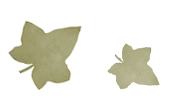|
A History of Witchcraft
an article by Blackhawk
Witchcraft
is almost as old as Man. It stems from the days
- long before the magicians of Egypt or Mesopotamia
- when science and religion were one complete whole,
rather than the two opposing camps we see today.
In those early days knowledge was not a luxury,
but a necessity. Knowledge of Nature, of Healing,
and of the appeasement of gods was commonplace.
The use of flora and fauna would have been learned
at an early age in compact, tribal units.
However, not all knowledge was within the grasp
of the common man. The initial limitations were
those of intelligence and social position. Those
with less of a capacity for learning [certain subject
matter at least] than others would struggle, or
would rely on those with greater intellectual strengths.
Some would find that their position in the tribal
structure would limit the time available for the
study of knowledge they would rarely apply to their
lives : a hunter may learn all about the hunt, the
kill and the dismemberment of a variety of creatures,
and even learn about edible plantlife that the group
may come across while hunting, but such a lifestyle
could quite often mean that knowledge concerning
tribal life away from the hunt would pass them by.
Vice versa, those who would gather plants, cook
and heal, would have little time or inclination
to learn of the ways of the hunt. Specialisation
requires time and dedication to be effective, and
so for most people it was less preferable to be
a jack of all trades than to be a master of one.
In such situations, also, spiritual life would be
entwined with day-to-day living. The traditional
division of labour, with each facet associated with
a deity or similar form, would lead to a selection
of religious sub-groups within the tribe. Depending
on location and situation, the main tribal deity/ies
could be local creatures [Nile Crocodiles], geographical
features [mountains / volcanoes, the sea] or stellar
features [the Moon, Sun and / or stars]. These deities
would be given attributes which would reflect the
hopes, aspirations or fears of the tribe, and would
be assigned personalities and powers [creative,
loving, destructive, vengeful, power over lightning,
volcanoes, the earth, sky or the heavens]. The personal
make-up of these deities, seen from a human perspective,
would include human attributes and features. Woman
/ Goddess, bearer of life, creatress, mysterious
to man, shedder of blood. Man / God, fierce destroyer,
protector, warmaker, hunter.
Beneath these major figures in the tribal pantheon
would be the gods or spirits of animals, plants
and geological structures. These spirits would develop
personalities and mythologies which would reflect
the relevance of the animal / plant / structure.
A river god could be a kind, benevolent deity, offering
himself / herself generously throughout the year,
save for the time when the violent, unstoppable
god of the glacier would fall upon the river god
and the two would fight hard enough to shake the
very ground. The valley in which they fought would
be filled with blood [water] which would destroy
everything it touched. When the fight was over,
the river god would be the victor - and life would
spring from the blood which had been shed - but
only until s/he faced the same enemy a year later.
The story would be told within the tribe, and possibly
beyond, and all those who entered the valley would
know when the fight was to take place, and could
withdraw to a safe location to watch the battle
unfold.
An
animal spirit could be approached, a liaison arranged
by those who knew him / her best, to request blessings
or favour in the hunt for this creature.
A plant spirit may be known to be a beautiful maiden
with a kiss which would kill any man who fell for
her [if the plant were pleasing to the eye, but
poisonous to eat].
The division of labour, of knowledge, and of deities
ensured that much knowledge was passed on within
social dividing lines [although much was shared
by the tribe as a whole, including the celebration
/ worship / fear of the main deities].
As time progressed, and the tribe became the society,
and in turn the civilisation, knowledge continued
to be passed on within more narrow social divides.
Apprentices were chosen from certain social groups
or castes, and knowledge became more specialised
and hidden from view of the majority. Blacksmiths
were at times credited with magical powers, or associations
with spirits both good and bad, as they alone in
a village knew the secrets of metal and fire. Druids,
shaman and priests would mediate between god/s and
Man. The ancient knowledge of Nature, and the stories
which had helped lead Man to survive long enough
to form societies and nations, was passed on down
family lines, or apprentices, but - as Man’s view
of himself and his place within the universe changed
- much of this old knowledge was seen as irrelevant
to those who now lived in towns and cities.
The spread of Christianity [* in other parts of
the world, Islam] as a political / religious power
destroyed many of the lines of knowledge which had
been passed down through countless generations.
Many of the old stories and rituals / ceremonies
contained ideas which Christians considered laughable,
heretical or even evil. The spirits of Nature; of
woodlands and rivers were demonised, and their connection
to Man largely severed. Any remnants of Goddess
& God worship, or celebrations of festivals which
stemmed from pre-christian times were either destroyed
[architecture was destroyed, events banned and ‘heretics’
tortured and killed] or ‘adopted’ [Yule becoming
christmas, Ostara becoming easter, Samhain turned
to halloween] in a bid to rid all Christian areas
of Pagan influence.
Propaganda and disinformation was used to create
the legend of ‘The Witch & The Devil’, in which
groups dedicated to evil [the Old Ways] would carry
out abominable acts in the name of the Devil [a
Christian construct based on pre-christian imagery],
and could be accused of perpetrating malicious acts
against their fellow villagers / townsfolk / citizens.
The ‘scapegoat’ approach worked very well, as life
was hard for many people, and having a target to
attack to dispel feelings of anger, hurt or impotence
was welcomed. A whole mythology was created. From
being individuals and groups within society, those
using ancient knowledge or paying homage to pre-christian
ways were turned into caricatures of evil - cackling
witches flying on broomsticks to attend sabbats
[gatherings of evildoers intent on orgies, human
sacrifice and other malevolent acts] with the Devil.
This approach, however, was eventually halted -
possibly because it could not be controlled, as
the numbers of accusations of witchery increased
drastically in times of hardship or strife [i.e.
quite often].
Politics,
ignorance and deceit helped destroy much of the
pre-christian ways, but knowledge continued to be
passed down. Some knowledge was diluted, other ideas
skewed by the changing nature of Man’s existence,
but the underlying essence - our connection with
Mother Earth / Gaia / The Horned God / Pan / the
spirits of Nature and creation - remained.
As Science split from Religion, and the Industrial
Age dragged Mankind further from Nature, most traces
of hidden knowledge were buried, much of it forever.
The Witch was rarely persecuted to the point of
torture or death [though harrassment continued]
but was seen instead as an almost mythical creature.
The Witch became a bogeyman, used to scare children.
The use of herbs to improve the quality of life
and to heal became potions and concoctions composed
of toads, frogs, eyes of newt. The Witch became
predominently female, ugly, cunning and evil. Her
‘familiar’ was the Devil in animal form. The cauldron
and broomstick became symbols of individuals who
had been granted almost demonic status. Festivals
were lost beneath layers of Christian deceit. Natural
healing fell to chemistry and the mass-produced
pill. The Old Ways had been crushed under the wheels
of Progress, and were no longer a threat to Christian
dominance. Fear turned to laughter and ridicule,
and the law which prohibited the spreading and use
of ancient knowledge and ways was repealed.
But, even as the laws which prohibited ‘Witchcraft’
were being overturned, there were some who still
hung on to delicate strands of knowledge, eager
to preserve and nurture knowledge and belief. Several
works were written documenting the existence of
practitioners of ancient rites and ceremonies and,
by the middle of the twentieth century, Wicca was
born.
Wicca can be seen as the child of the Old Craft.
Weaving numerous strands of belief and knowledge
together into a new whole, with a pattern reminiscent
of - though probably not identical to - the true
ways of our ancestors. It is, in effect, man-made,
and seeks to establish - to some degree - the old
within the new. Wicca is a popular belief system,
positive in outlook, offers gender equality and
respect for the environment, but its most positive
attribute is that it has made discussion of, and
research into, the ancient knowledge which our ancestors
tried so hard to pass down to us possible and respectable.
Today there are hundreds of thousands of individuals
working to bring back to Mankind the knowledge,
practices and beliefs which allowed us to thrive
as a species in the cold days before the dawn of
history. We will never discover everything, and
much may no longer be relevant, but the search itself
is much more than could have been hoped for even
a hundred years ago. The God & Goddess have been
reborn, the spirits of woodland and stream are frolicking
once more, festivals are celebrated and understood,
witches have been rescued from hateful caricature
and - at last - we have hope. |
|












